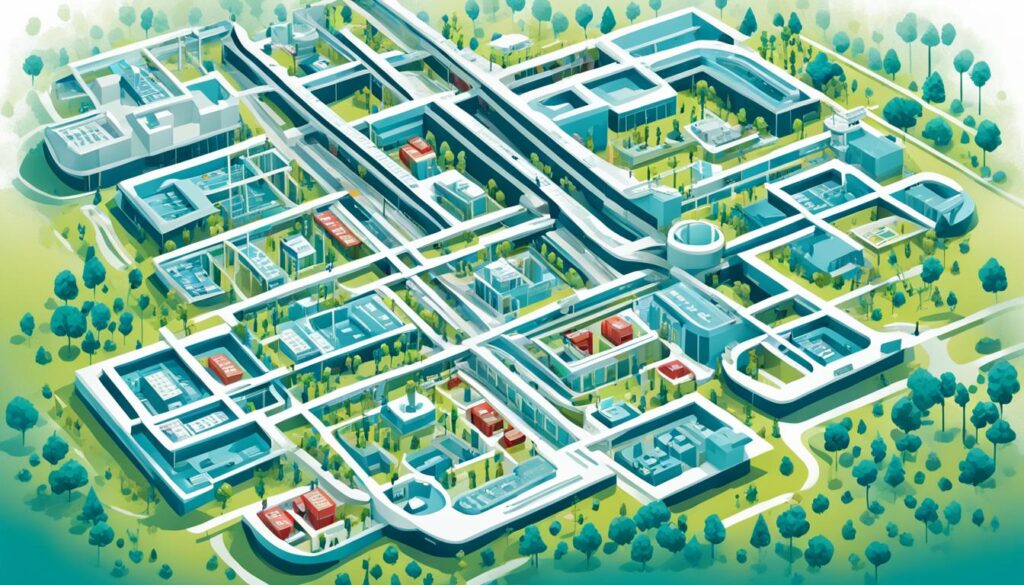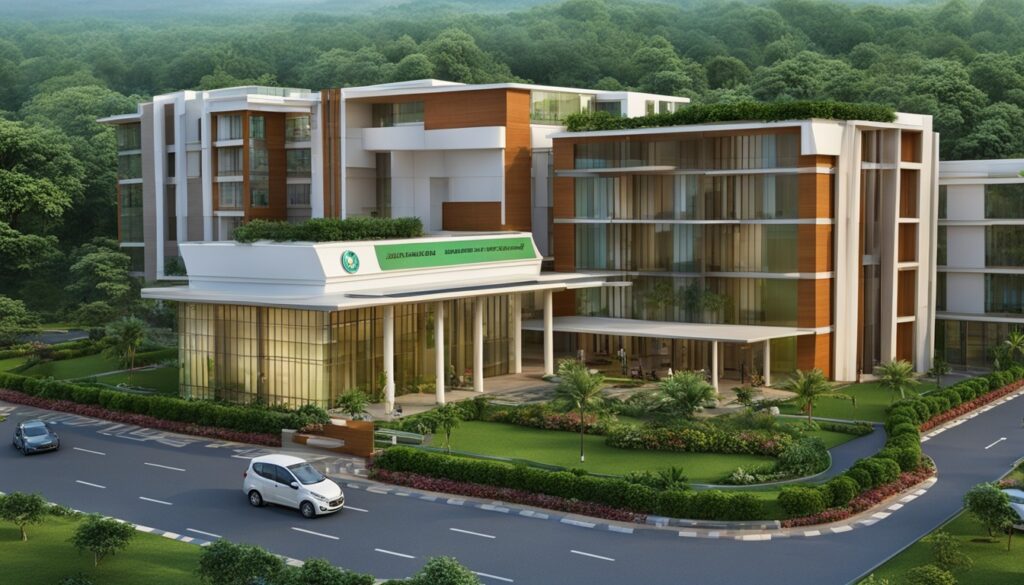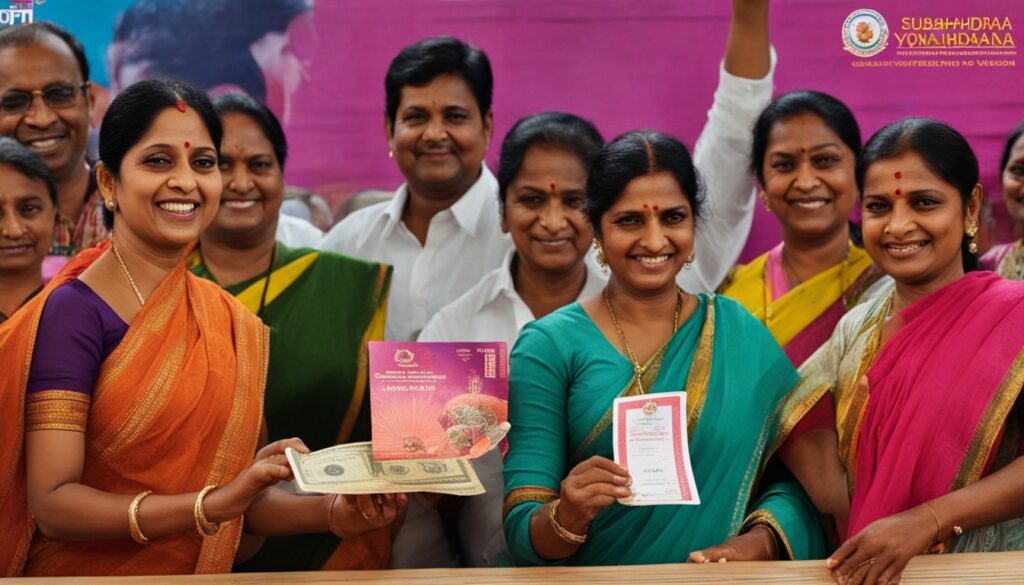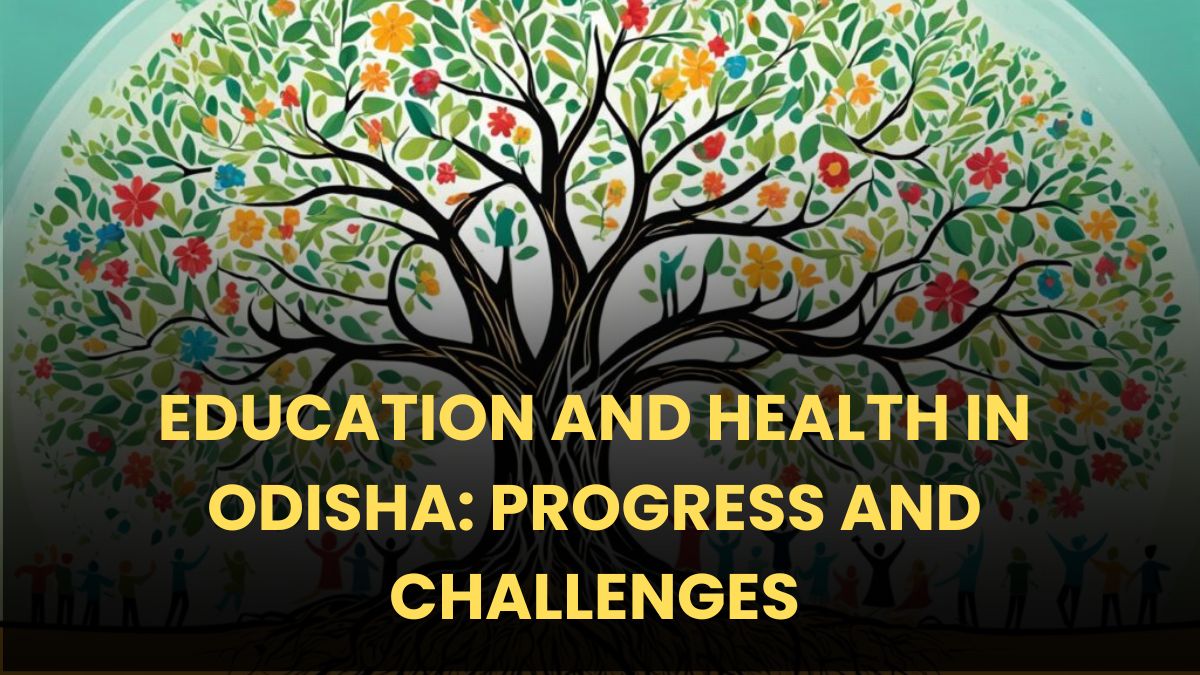Odisha, also known as Orissa, is a big state in eastern India with about 35 million people. It has slowly gotten better in health thanks to new developments, education, and better healthcare. Yet, it still has big challenges in health and education. These include hard-to-reach places, cultural issues, poor service quality, and a lot of people using informal health services. This article will look into Odisha’s journey in education and health.

Key Takeaways
- Odisha’s health spending is only 0.57% of its gross state domestic product, much less than the national average.
- Infant and under-five mortality rates in Odisha are still high, at 65 and 81 per 1,000 live births, respectively.
- Institutional deliveries and full immunization coverage in Odisha are below national goals, at just 44% and 71%, respectively.
- Odisha lacks a lot of healthcare infrastructure, with only 120 doctors and less than 4 beds per 1 million people.
- The state’s education system has problems like low literacy rates, high dropout rates, and unequal access in rural areas.
Overview of Odisha’s Education and Health Sectors
Odisha has made great strides in improving health, but there’s still work to do. The state has launched many projects to lower infant and child deaths. Yet, these rates are still above the national average. Also, more women are giving birth in hospitals, but not enough have the skills or facilities to help everyone.
Progress in Health Indicators
Odisha has done well in fighting diseases like malaria and managing HIV/AIDS. The state’s healthcare system has gotten stronger, showing in better health numbers. But, it still trails the national average in life expectancy and death rates.
Challenges in Education Outcomes
In education, Odisha faces big hurdles. Many students drop out, and there are gaps in learning. The state is working to improve education access and quality. Fixing these issues is key to boosting Odisha’s human development.
| Indicator | Odisha | National Average |
|---|---|---|
| Life Expectancy | 65.8 years | National Average |
| Crude Death Rate | 7.8 | National Average |
| Infant Mortality Rate | 40 | 41 |
| Under-5 Mortality Rate | 48 | 50 |
| Stunting | 34.1% | 38.4% |
| Wasting | 20.4% | National Average |
| Underweight | 34.4% | National Average |
Health disparities in Odisha come from unequal resource distribution and healthcare access issues. These are based on where people live, their ethnicity, and their economic status.
Health System Performance and Infrastructure
Odisha has worked hard to improve its healthcare setup. It has set up new health centers in various places. But, it still faces issues like not having enough doctors and hospital beds. This makes it hard to give full medical care to everyone.
Maternal and Child Health Initiatives
The government of Odisha has focused on helping mothers and children get better healthcare. But, there are still big problems, especially in rural areas. These areas often don’t have enough healthcare services for women and kids.
Dehury (2021) talked about the challenges in giving health care to tribal areas. Kanrar, Goswami, & Roy (2023) pointed out health issues in indigenous communities, especially for tribal groups.
Rural and Urban Healthcare Disparities
In Odisha, there’s a big difference in healthcare between rural and city areas. Majhi & Mallick (2018) showed how health centers have grown in tribal areas. But, Mohanty (2023) said there aren’t enough clinics in these distant places.
The MoHFW & MoTA, GoI (2017) report talked about the need to improve healthcare for tribal people. Many studies agree that Odisha’s poor communities need better health care.
| Health Indicator | Odisha | National Average |
|---|---|---|
| Under Five Mortality Rate | 48 | 37.4 |
| Maternal Mortality Ratio | 180 | 113 |
| Infant Mortality Rate | 40 | 28.0 |
| Neonatal Mortality Rate | 24 | 22.0 |
| Children under 5 stunted | 34.1% | 35.5% |
| Children fully immunized | 78.6% | 78.9% |
The data shows Odisha still faces big challenges in taking care of mothers and children. It’s behind the national average in many health areas. Fixing these issues and improving healthcare is very important for the state.

Health Financing and Public Expenditure
In Odisha, healthcare financing is a big challenge. Most health costs come from what families pay out-of-pocket. This means about 80% of health spending is from these payments, making life hard for many families.
Government Healthcare Spending
The Odisha government spends less on healthcare than it should. Most of the little money it does spend goes to paying staff. This means there’s not much left for improving health services or building new ones. This lack of money makes getting good healthcare hard for some people.
Out-of-Pocket Expenditure Burden
The high out-of-pocket burden, especially for outpatient care and medicines, is a major concern in Odisha. From 1995 to 2014, more people went to the hospital, and spending on health doubled. Many families in Odisha spend a lot on health and end up in poverty because of it.
| Indicator | Value |
|---|---|
| Total health expenditure in Odisha (1996-97 to 2007-08) | Rs. xxx crores |
| Per capita health expenditure in Odisha (1996-97 to 2007-08) | Rs. xxx |
| Share of health expenditure in total state expenditure and GSDP in Odisha (1996-97 to 2007-08) | xxx% |
| Average real per capita health expenditure in major Indian states (1991-92 to 2006-07) | Rs. xxx |
These numbers show how hard it is for families in Odisha to pay for healthcare. They rely a lot on their own money and the government doesn’t invest much in healthcare.
EDUCATION AND HEALTH IN ODISHA
Odisha has made great strides in education and health, but there’s still a lot to do. The state has launched many programs to improve access and quality in these areas. Yet, challenges like not having enough resources, differences between rural and urban areas, and poor service delivery slow down progress.
The DMET was set up in 1975 to boost healthcare education and training. It oversees programs for doctors, dentists, and other health workers. DMET also helps bring new technology to healthcare and guides medical education and treatment in the state.
Even with these efforts, we don’t know much about how well DMET’s programs work. There’s no info on how many medical schools or hospitals DMET oversees, or how many students are enrolled. We also don’t know about graduation rates or how well the healthcare training programs do.
In education, Odisha has increased medical seats a lot, from 321 to 2,525. It has also added more specialist courses, from 254 to 1,044. But, there are still big challenges in providing good education, especially in rural areas, because of a lack of resources and infrastructure.
To fix these issues, the government is investing in big projects. For example, it’s spending Rs 4,500 crore over 5 years to improve the SCB Medical College and Hospital in Cuttack. Also, a new Bagchi-Karunashraya Palliative Care Centre is being built in Bhubaneshwar for Rs 110 crore.
Odisha has made good progress in education and health, but there’s more to do. The state needs to keep investing in these areas for better access and outcomes for everyone. Overcoming the challenges will be key to improving the education and health status in Odisha.

Private Sector’s Role in Healthcare Delivery
The private healthcare sector in Odisha is key to the state’s healthcare. Most people go to private providers for care, like chemist shops and solo doctors. This is because public places often don’t have the drugs or work the same hours.
The private sector’s role in Odisha’s healthcare has grown, but there are worries about quality and responsibility. Private care is mainly in cities and rich areas, leaving poor areas behind. This means some people can’t get the care they need.
Private healthcare in Odisha has big challenges. There are untrained doctors, high costs, and many people pay out-of-pocket. Yet, the private sector is vital for filling service gaps and tackling health issues. It helps make health better for everyone.
| Key Statistic | Value |
|---|---|
| Odisha’s public sector health expenditure as a percentage of Gross State Domestic Product | 1.2% |
| Infant Mortality Rate in Odisha (1999) | 97 |
| Maternal Mortality Rate in Odisha (1992 to 2000) | 738 to 367 |
| Institutional deliveries in Odisha (1980 to 2000) | 22.6% to 33.6% |

To fix the private healthcare sector in Odisha, we need to make care more accessible and affordable. We should also focus on making care better. This means better rules, working with both public and private groups, and improving healthcare in rural areas. These steps will help the private sector give better and fair healthcare to Odisha’s people.
Quality of Care and Patient Satisfaction
In Odisha, the quality of healthcare is a big concern. There are big issues with how well providers work and how safe patients feel. Surveys show big gaps in the care quality and how patients feel about their care.
Provider Competence and Treatment Practices
Tests show that many patients don’t understand a lot of the questions about their care. This means there might be problems with how doctors and patients talk to each other. Also, how well patients like their care is closely linked to how well they get along with doctors and nurses.
Patient Safety and Care Experience
Patients from lower social groups often say they’ve gotten bad care, but they’re still pretty happy. This shows that many patients might not expect much from their healthcare. Quality of healthcare in Odisha, provider competence, patient safety and satisfaction are big problems that need quick fixes.
| Key Findings | Value |
|---|---|
| Inpatients surveyed across public hospitals in Odisha | 507 |
| Survey questions not consistently understood by inpatients | 6 out of 18 |
| Variance explained by the identified factor structure | 66.7% |
| Strongest association with overall satisfaction | Interpersonal care from doctors and nurses |
The big problems with quality of healthcare in Odisha, provider competence, patient safety and satisfaction show we really need to make big changes. We need to work on making the care better and making patients happier with their care.
Educational Infrastructure and Resources
Odisha has worked hard to improve its schools and classrooms. But, it still struggles to give all students the resources they need, especially in rural areas. Problems include too many students for teachers and not enough classrooms, making it hard to give quality education to everyone.
Student-Teacher Ratios and Classroom Facilities
Odisha has 67,961 schools for students from Class 1 to 10. The state has many schools, but it’s not enough for the growing number of students. The student-teacher ratio is about 25:1, which means not enough teachers for all students. Some areas have even worse ratios.
Many schools don’t have the right classrooms for good teaching and learning. The physical infrastructure index for primary schools in Odisha shows how different districts have different levels of classroom amenities.
| Indicator | Metric |
|---|---|
| Total Schools (Class 1-10) | 67,961 |
| Total Teachers (Class 1-10) | 2,84,464 |
| Student-Teacher Ratio | Approximately 25:1 |
| Primary Schools (Class 1-5) | 36,070 |
| Primary & Upper Primary (Class 1-8) | 18,712 |
| Upper Primary only (Class 6-8) | 3,307 |
| Secondary Schools (Class 9-10) | 9,872 |
These findings show that Odisha needs to focus on improving educational infrastructure in odisha. It’s important to work on student-teacher ratios and classroom facilities. This will help make sure all students have equal access to good education.
Challenges in Rural Education Access
Odisha has made progress in education, but rural areas still face big challenges. Being far from cities, lack of transport, and cultural issues stop many kids from going to school. This is especially true for kids from poor backgrounds.
Many rural schools lack basic things like electricity and clean water. They also don’t have enough books and technology. This makes learning hard for students.
There aren’t enough teachers in rural areas, especially in important subjects. Attracting good teachers is hard. Girls in some rural areas face extra barriers to getting an education.
Being far from schools is a big problem. Families in rural areas often can’t afford to send their kids to school. This means kids miss out on their education.
The government is trying to help with programs like the Sarva Shiksha Abhiyan. These programs aim to get more kids in school and keep them there. The Digital India program also helps by bringing internet and digital tools to rural areas.
Groups like CRY India are working to make learning better in rural areas. They help communities and push for changes in education policies. By tackling these issues, Odisha can make education better for all kids, no matter where they live.
| Indicator | Rural Odisha | Urban Odisha | National Average |
|---|---|---|---|
| Computer Literacy Rate | 13.4% | 25.5% | – |
| Internet Access | 5.8% | 29.3% | 38.02% |
| Households with Computers | 1.8% | – | 4.3% |
| Wireless Tele-density | 61.6 | 160.8 | 91.09 |
“Addressing the disparities in rural education access is crucial for Odisha’s overall educational development.”
Government Initiatives and Policy Reforms
The Government of Odisha has launched many initiatives and policy reforms. These aim to make education and health better. They work to increase access, quality, and outcomes in these areas. They also focus on inclusive development across the state.
National Health Mission and Digital Health Mission
The National Health Mission (NHM) is a key program by the Indian government. It has greatly improved healthcare in Odisha. The mission focuses on the health of mothers and children.
It has started the “Shishu Abond Matru Mrutyuhara Purna Nirakaran Abhiyan (SAMPURNA) scheme.” This scheme gives financial help to pregnant women. It aims to lower Infant Mortality Rate (IMR) and Maternal Mortality Rate (MMR).
The state has also started the Digital Health Mission. This mission uses technology to make healthcare better. It includes the “ANMOL Yojana,” which gives ANMOL Tablets to Auxiliary Nurse Midwives (ANMs). These tablets help improve services for pregnant women, mothers, and newborns.
These government initiatives for education and health in Odisha are showing good results. However, they need ongoing assessment and improvement. This will help achieve the desired outcomes.
| Government Initiative | Key Details |
|---|---|
| Biju Swastya Kalyan Yojana | Launched in 2018, aims to provide financial assistance for healthcare to about 3.5 crore people in Odisha, with annual health insurance coverage of Rs 5 lakhs per family and 7 lakhs per women members of the family. |
| Kalia Yojana | Launched in 2018, stands for “Krushak Assistance for Livelihood and Income Augmentation,” benefiting farmers in Odisha. |
| Mukhyamantri Kalakar Sahayata Yojana (MMKSY) | Initiated in 2018, provides financial assistance to literature and cultural artists. |

Conclusion
Odisha has made great strides in education and health, but there’s still a lot to do. The state faces challenges like not having enough resources, big differences between rural and urban areas, poor service quality, and high healthcare costs. To overcome these, the state needs to work together, invest wisely, and make government plans work well.
Odisha has seen some good changes, like new medical colleges and basic health services. Yet, it has some of the highest Infant Mortality Rate (IMR) and Maternal Mortality Rate (MMR) in India. The National Rural Health Mission (NRHM) has helped rural health a bit, but there’s still a lot to do. We need better healthcare access and quality, especially in tribal and hilly areas.
In education, Odisha has improved girls’ literacy, but many girls still drop out. Programs like SABALA, the Odisha State Policy for Girls and Women, and Beti Bachao Beti Padhao aim to help. But, child marriage, negative views from parents, and household duties still stop girls from getting an education. We must keep working to remove these obstacles and create a better environment for girls to learn.
FAQ
What is the current state of education and health in Odisha?
Odisha has seen improvements in health, but still trails the national average. Education faces hurdles, like high dropout rates and learning gaps.
How has Odisha worked to improve its health infrastructure?
Odisha has set up new health centers but still lacks enough doctors and beds. Efforts focus on improving maternal and child health, but rural areas face challenges in accessing quality care.
What are the key challenges in health financing in Odisha?
Odisha’s health funding is complex, with most costs paid by households. The state spends less on healthcare than advised, with most funds going to salaries, leaving little for infrastructure and services.
What is the role of the private sector in healthcare delivery in Odisha?
The private sector is a big part of healthcare in Odisha, handling most outpatient care. But, concerns about the quality and accountability of private care need attention.
What are the challenges in the quality of healthcare in Odisha?
Healthcare quality in Odisha is a big worry, with providers often not skilled enough to diagnose and treat common illnesses. There are also issues with unsafe practices and reporting of patient safety problems.
What are the challenges in educational infrastructure and resources in Odisha?
Despite efforts, Odisha still faces challenges in education, like too few teachers and poor classrooms, mainly in rural areas. These issues make it hard to offer quality education to all students.
What are the key challenges in rural education access in Odisha?
Getting to school is hard for many in rural Odisha. The distance, lack of transport, and cultural barriers stop many, especially from poor backgrounds, from going to school.
What government initiatives and policy reforms have been introduced in Odisha to address the challenges in education and health?
Odisha has launched programs like the National Health Mission and Digital Health Mission to better health and use technology in healthcare. But, we need to check how well these programs work and improve them.
